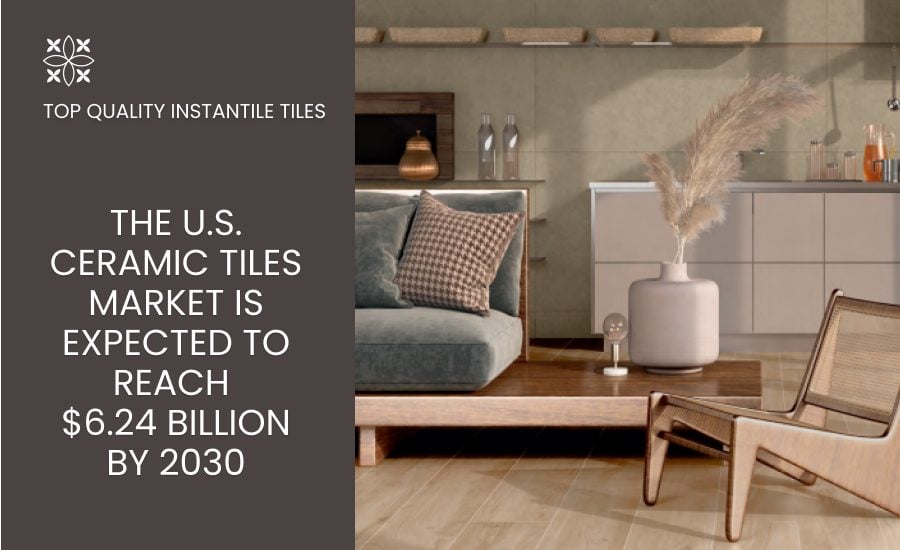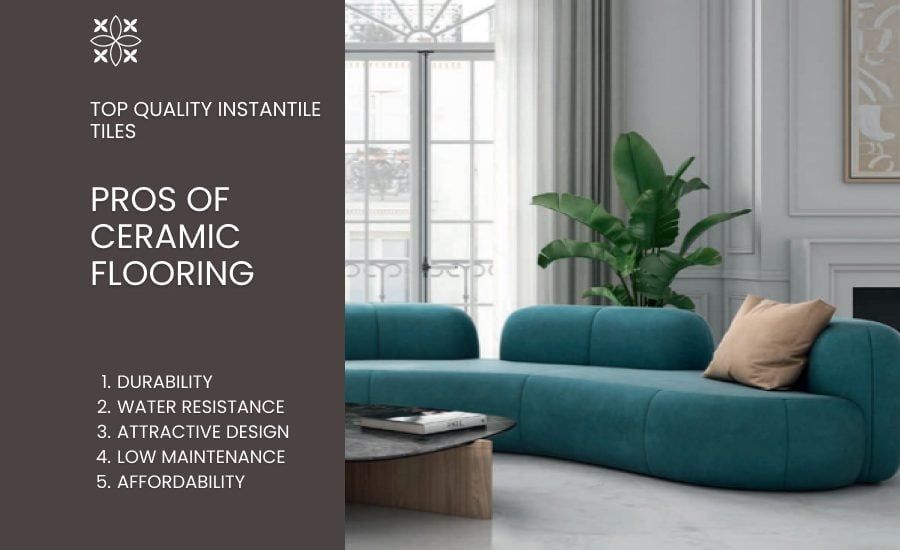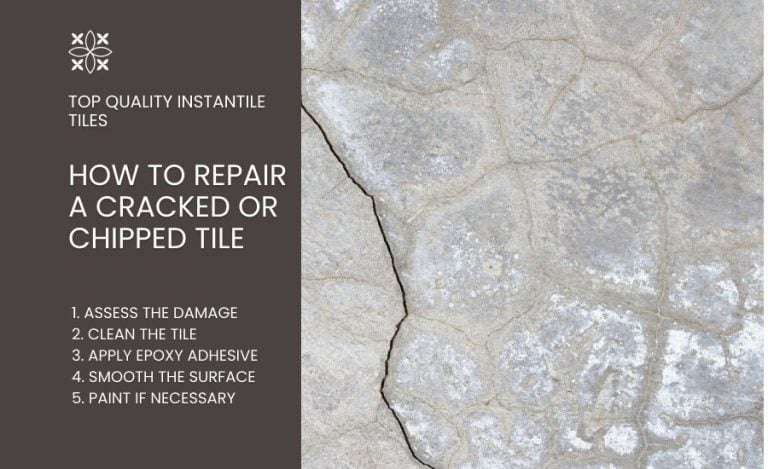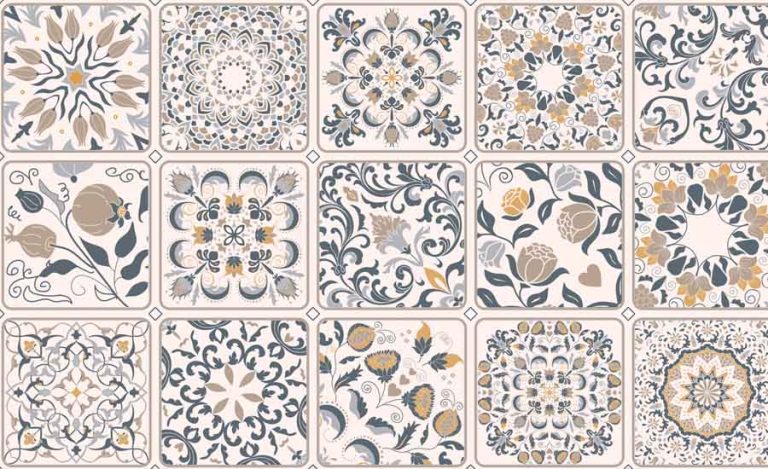Ceramic Flooring: Key Takeaways
- The benefits of ceramic flooring are its cost, low maintenance requirements, design flexibility, durability, and water resistance
- Ceramic tile drawbacks include being hard and chilly underfoot, becoming slick when wet, and requiring precise installation
- Ceramic tiles are a popular flooring choice, and their use is predicted to increase due to the benefits they offer
- When buying tiles, consider the intended design style, the room’s moisture level, traffic volume, and ease of maintenance
If you are in the middle of a commercial or home project, the variety of flooring alternatives on the market may leave you feeling overwhelmed.
If you’re considering ceramic tiles, we’ll help you with the choice by sharing:
- The expected growth of the ceramic tile market, accounting for their popularity
- The pros and cons of ceramic tiles
- How to choose tiles for your project
Pros of Ceramic Tiles
Let’s explore the benefits of ceramic flooring and why this option is such a popular go-to.
Durability
Resistant to scratches and daily wear and tear, ceramic tiles can withstand various challenges, from partying all night in high heels to a wedding with hundreds of dragged chairs.
Its durability is based on high-temperature firing applied during production.
As the heat in the kiln reaches 2,000 °F, the clay, sand and minerals transform; the water evaporates, and the clay particles are brought together to form a hard and dense tile. Adding glaze on top makes the tiles even stronger.
Water Resistance
If correctly sealed, the compact nature of ceramic tiles prevents water from leaking in. They receive an extra layer of non-porous protection when glazed, which increases their water resistance even more.
Because of this, they are a great option for damp spaces like kitchens, bathrooms, patios, and swimming pools.
Attractive Design
Extremely versatile, ceramic tiles can give your space any look you want, from white elegance and black extravagance to wood-effect coziness and stone-effect modernity.
This allows you to adapt them to your needs and preferences and recreate traditional, rustic, or industrial project appearance.
Low Maintenance
Unlike wood flooring, which needs refinishing to keep its shine, or stone flooring, which needs sealing to stay moisture-resistant, ceramic tiles need little upkeep.
Regular sweeping and mopping are all you need to do, and they will reward you with a fresh and attractive appearance for many years.
Affordability
Want to achieve the cozy look and feel of wood or the gentle elegance of marble without all the costs of natural materials?
Ceramic tiles with a wood or stone effect can give you the desired look at a fraction of the price.
And there’s more good news. If you choose interlocking tiles, you will save on adhesive, installation, and labor, too!

The popularity of ceramic flooring is expected to grow
Cons of Tile Flooring
Although there is no denying the benefits of ceramic flooring, there are a few drawbacks to consider before choosing.
Hard and Less Comfortable
Although the hard surface makes them resilient to normal wear and tear, it can also be a disadvantage, particularly if your job or tasks demand you to stand for extended periods of time.
Ceramic flooring may not feel as comfortable as options like wood or vinyl.
The solution? Pair ceramic tiles with radiant heating.
Cold Under Your Feet
If you live in colder climates, it may be uncomfortable to feel their cool touch, even though it’s refreshing in the summer heat.
Don’t give up, though; if you enjoy keeping your feet warm in cold weather, think about combining them with radiant heating.
Slippery When Wet
When wet, ceramic tiles can become slippery, increasing the risk of falls and injuries. If you are planning to use them in wet areas like entryways and bathrooms, opt for tiles with textured surfaces or anti-slippery finishes.
Complex Installation
Traditional tile installation involves time-consuming steps like leveling the subfloor, measuring and cutting the tiles, and applying mortar and grout, which requires skill and precision.
To eliminate these challenges, especially if you want to do the installation yourself or are pressed for time, opt for interlocking tiles. They are fast and easy to install and do not require specific tools.
Grout Maintenance
While you’ll benefit in the tile maintenance department, grout may need more attention, as it can stain or fade over time.
To keep the grout lines fresh and clean, scrub and seal them regularly.

Despite their benefits, ceramic tiles can feel hard and cold and become slippery when wet
Is Ceramic Flooring Popular?
The U.S. ceramic tile market is expected to grow from $4.94 billion in 2025 to $6.24 billion by 2030.
This flooring type’s growing popularity is due to its versatile design, impressive durability, and easy maintenance, and these are only a few of the benefits ceramic flooring offers.
How To Choose Ceramic Flooring for Your Residential or Commercial Project
Investing in flooring in residential and commercial projects is a serious step; that’s why it’s important to consider several key factors.
- Foot traffic: For areas with high foot traffic like commercial lobbies, hallways, or kitchens, choose tiles with higher Porcelain Enamel Institute (PEI) ratings.
- Environment: For wet environments like bathrooms and outside areas, opt for tiles with good water resistance and anti-slip surfaces. Consider your flooring options’ Coefficient of Friction (COF) ratings; the higher the rating, the better the grip and slip resistance.
- Design: If you’re looking to create a warm, rustic look, consider terracotta tiles. If you prefer sleek, modern designs, go for large-format tiles in neutral colors. If you want to achieve a bold, artistic vibe, opt for geometric shapes and colorful accents.
- Maintenance: For busy households or business lounges, choose tiles with darker grout for less visible stains.
Ceramista Is Synonymous With Top Quality Flooring
Ceramista offers the innovation and quality real estate developers, architects, and homeowners are looking for.
Our INSTANTILE interlocking system allows installation that is nine times faster than traditional methods to help you save time, labor, and money.
You don’t need adhesives or special tools; just snap the tiles together at the edges just as you would with a jigsaw puzzle. If a tile is damaged, you simply remove that puzzle piece and replace it with a new one, leaving the surrounding tiles undisturbed.
In addition to the click-together system, you’ll experience beautiful design, Spanish quality and eco-friendly production that make Ceramista a trusted partner for renovations or new projects.
Ceramic Flooring: FAQs
For more insights into ceramic flooring, check out our section that answers your commonly asked questions.
What’s the lifespan of ceramic flooring?
Ceramic flooring can last for decades if you take good care of it. For simple cleaning tips, check out our detailed guides on:
Can I use ceramic tiles for outdoor spaces?
Yes, there are ceramic tile types that are frost-resistant and have an anti-slippery finish, which makes them a great choice for patios, balconies, and terraces. Talk to our experts at Ceramista to find the best tiles for your needs.
Are ceramic floors safe for people with allergies?
Yes, the non-porous surface of tiles doesn’t hold dust, pollen, or pet dander, improving air quality and supporting your health if you suffer from allergies.




